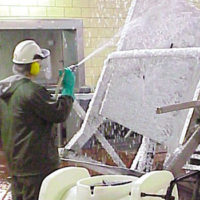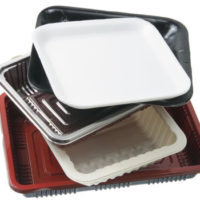Selecting the equipment used to spray, pump, dispense, proportion or otherwise apply cleaning chemicals and sanitizers in the food processing and handling facility is as important as selecting the chemicals themselves. "More stringent food safety and sanitation requirements are in effect in today's food plants," says Clint Heffer, Vice President, Equipment Division with Birko Corp. "To meet or exceed those sanitary standards, food processors are constantly looking for the most effective cleaners and sanitizers, as well as the best way to apply these chemicals, from both a worker safety and an efficiency standpoint."
Heffer represents the third generation in this family-owned company to design, build and install sanitation chemical application equipment to enhance its line of specialty cleaning chemicals used in the meat, poultry and food industries. Since 1953, when his grandfather started the company out of his garage, Birko Corp.'s product line has grown to include 300 chemical formulations and a wide range of dispensing and application equipment.
According to Heffer, plant cleaning, sanitation and production operations efforts are greatly enhanced when the operator is using the right equipment to dispense the right amount of chemical for a specific process at the correct time. However, he notes, "The effectiveness of sanitation activities in the food plant can be hampered by a number of factors. For example, there is still a lot of antiquated equipment being used, such as drum pumps, which can cause worker exposure to the chemical. Another significant factor is the often high employee turnover in the sanitation department, which means that a certain percentage of your personnel may not be completely familiar with the proper use of the chemicals or equipment. This is a key issue that can greatly affect whether the plant's sanitation efforts will be adequate."
Heffer suggests a few key considerations in selecting sanitation chemical application equipment that can aid food processors in getting the most out of their cleaning and sanitizing regimens:
1. Select Equipment That Increases Worker Safety. One of the most important advances in reducing worker exposure to cleaning and sanitizing chemicals has been the development of automated chemical dispensing equipment. "These computer-controlled chemical dispensing and allocation systems reduces worker exposure to the chemical, eliminating the need for drum pumps, for example, where workers have traditionally pumped chemical out of a drum into a bucket and then carried that bucket of chemical throughout the plant," explains Heffer.
For instance, says Heffer, Birko's automated dispensing system, AlloTrax, is "like an automated teller machine (ATM) system for chemicals." In this type of system, sanitation management can predetermine what chemicals will be used and how they will be applied, in what areas of the plant and when, as well as specify which employees are authorized to apply certain chemicals. Each employee is provided a code to enter into the system, much like an ATM card pin number, which ensures that only the correct chemicals are dispensed to employees who know how to use and apply them properly.
"Also, by utilizing an automated allocation device, a chlorinated caustic cleaner is not going to be mistakenly used in combination with an acid cleaner by an inexperienced employee--a situation in which you could create a poison gas with the potential to send workers to the hospital. Automated equipment such as this prevents incompatible chemicals from being used with one another, and again, enhancing worker safety."
2. Select Equipment That Does Not Contribute to Cross-Contamination. Sometimes, the application equipment itself can contribute to inadequate hygiene in the plant, especially when it is a portable unit that comes into contact with the production equipment, food contact surfaces, or even food products, that are meant to clean or sanitize. "Steam vacuums used in the meat and poultry industry, for example," says Heffer, "are used to actually vacuum carcasses as a sanitary measure. But these steam vacuums touch each carcass, one after the next, which presents a cross-contamination issue."
Birko currently is testing a pump assembly that uses a lactic acid spray in the steam vaccuum itself to kill whatever bacteria remain on the carcass and prevents any cross-contamination causing by the vacuum touching each carcass.
3. Select Equipment That Can Do What the Manufacturer Says That It Does. Sprayers, pumps, and foamers should efficiently spray, pump and distribute foam. Sanitation workers should not have to wrestle with unwieldy hoses, or take a guess about what chemicals are appropriate to use with what type of equipment. "Again," notes Heffer, "when you buy an automated chemical dispensing system, you expect it to automatically allocate predetermined amounts of chemical and pre-approved authorization of who's going to use what chemical in what area. The promise is that it will prevent the overuse of chemicals, ensuring that the correct chemical goes to the correct area."
"Whatever sanitation chemical equipment you choose to purchase," says Heffer, "you want to make sure that it is as easy and safe as possible for plant sanitation personnel to use and maintain chemical control. As with any equipment, factors such as convenience, durability and worker safety should be paramount."
birko.com
Getting the Most From Your Sanitation Equipment




